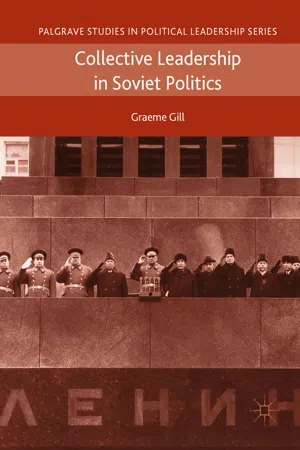- 1.It assumes that authoritarian leadership consists of a dichotomy, of the person of the dictator on the one hand and the other members of the leadership, his “allies ”, on the other. However, in practice, this is usually much more complicated. The leader is rarely alone in confronting the “allies ”, some of whom may actually support the leader rather than being in fear for their positions as Svolik seems to imply. This means that the “allies ” are not a homogenous group. Some may support the leader completely, while some will support him on some issues and not others. Some are therefore likely to be stronger supporters of the leader than others, and some may actually be opponents of the leader . This means there will not just be two actors, but potentially multiple actors in the game of elite politics. This is reflected in the diversity of models of collective leadership that are available (see below).
- 2.Svolik assumes that everything is about power, that this is the only issue of concern to the leadership. Antagonistic power relationships are therefore built into the leadership group by definition. But in real life, power is rarely the only concern. Policy may be important, with the result that conflicts may occur within the elite over issues other than power distribution. Of course, such issues may feed into the question of power distribution, but they may not, and in any event they create potential lines of division ignored in the Svolik model.
- 3.The assumption that a leader will inevitably seek to expand his personal power at the expense of his colleagues is something that needs to be established in each case, not simply assumed.
- 4.The assumption that violence is always present, even as a threat, as the means of resolving differences is not always correct. The role of violence needs to be established in each case rather than assumed as part of the structure of the model.
- 5.The model assumes that there are only two courses open to the allies : passivity and acceptance of the leaders’ power, or rebellion. In practice, the relationship may be much more nuanced, with a range of responses possible.
- 6.The discussion of the role of institutions is cast purely in terms of the way that, under certain circumstances, they may assist in the reining in of the dictator. But such institutions may also assist in a dictator’s search to enhance the powers at his disposal.
- 7.Although Svolik acknowledges that there may be agreements and rules of the game, he denies their importance by saying that there is no independent authority to enforce them. This assumes that such norms carry no independent authority themselves but rely for their application upon enforcement by an external authority. Such a view denies the possibility of there being assumptions, even a consensus , about how it is proper and correct to act, of norms that rely not on external enforcement but upon recognition of their own value and authority. Rejection of this possibility means politics is seen as a war of all against all with no rules . Such a view is unrealistic.

- English
- ePUB (mobile friendly)
- Available on iOS & Android
Collective Leadership in Soviet Politics
About This Book
This book studies the way in which the top leadership in the Soviet Union changed over time from 1917 until the collapse of the country in 1991. Its principal focus is the tension between individual leadership and collective rule, and it charts how this played out over the life of the regime. The strategies used by the most prominent leader in each period – Lenin, Stalin, Khrushchev, Brezhnev and Gorbachev – to acquire and retain power are counterposed to the strategies used by the other oligarchs to protect themselves and sustain their positions. This is analyzed against the backdrop of the emergence of norms designed to structure oligarch politics. The book will appeal to students and scholars interested in the fields of political leadership, Soviet politics and Soviet history.
Frequently asked questions
Information
1. Introduction: The Study of Soviet Leadership
Table of contents
- Cover
- Front Matter
- 1. Introduction: The Study of Soviet Leadership
- 2. Oligarchy with a Predominant Leader, 1917–22
- 3. Rule by Pure Oligarchy, 1923–29
- 4. From the Predominant to the Dominant Leader, 1930–53
- 5. The Limits of the Predominant Leader, 1953–64
- 6. Predominant Leader Within the Collective, 1964–82
- 7. Collectivism Collapses, 1982–91
- 8. Conclusion
- Back Matter